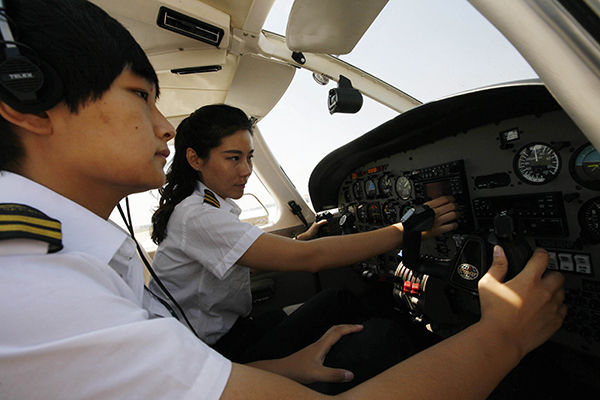Pilot-airport shortage could be an air pocket
 |
|
Pilots learn how to fly a business jet at a training institute in Xiangyang, Hubei province. [Photo/Xinhua] |
China faces a shortage of pilots and exclusive airports for business jets. Experts said the industry needs to respond to the situation soon as the business aviation segment continues to grow. The gap has already increased pressure on the growth of the segment.
Currently, China has around 300 business jets. This segment of the aviation market needs at least 1,200 pilots, if every jet is equipped with two pairs of pilots.
Last year, China saw 28 percent growth in individuals looking to buy or replace their business jets. This would mean the demand for business jet pilots and cabin crew will grow, according to Honeywell Aerospace.
By the end of 2015, China had 1,225 pilots with licenses to fly small aircraft for commercial transportation, according to the latest pilot report by the Civil Aviation Administration of China.
Compared with commercial airline pilots, business jet pilots require more abilities and need to perform more tasks. For example, business jet pilots need to communicate individually with the passengers, in addition to doing some ground work after landing.
Chinese business jet operators usually offer high salaries to attract captains, but it is not easy to draw staff from large commercial airlines, as many pilots prefer to stay on for career progression, stability and job security.
With confirmed routes and scheduled time at commercial airlines, pilots can accumulate more flying experience. In comparison, business jets fly less frequently and their schedules could change at short notice.
Besides, only a few major Chinese business jet operators such as Deer Jet are able to train business jet pilots. Training costs are very high. So, some domestic operators have to hire pilots from abroad.
Industry experts suggest that domestic operators and flying schools should further improve their training systems and mechanisms for business jet pilots.
Liao Xuefeng, chairman and chief executive officer of China Business Aviation Group, said: "China's business jet sector needs to hire a large number of foreign pilots, and the costs are two times higher than hiring domestic pilots, as the operators need to take care of pilots' family relocation issues.
"The costs of using business jets in China are also among the highest worldwide, about 50 percent higher than the United States'. This is part of the problems that arose during the growth of the sector. But the business aviation segment still shows a very promising development momentum."
That momentum needs to overcome infrastructure shortage though. In China, business jets now share the same airports with commercial airlines. Some airports have difficulty in arranging parking lots for business jets.
In addition, it takes about one to three days for business jets to apply for flying rights. The process is more complex than in other countries such as the US and those in Southeast Asia. This has also inflated costs in China.
It is projected that by the end of the 13th Five-Year Plan (2016-20) period, China will have 500 new airports, and more than 5,000 general aviation aircraft will be in operation. The general aviation industry's worth will exceed 1 trillion yuan ($1.4 billion), according to the Civil Aviation Administration of China.
"It's very positive that there are specific policies aimed at the sector. I think it will have a very positive impact, and will encourage more new people join the sector," said Andy Gill, senior director of business and aviation in Asia Pacific at Honeywell Aerospace.

















